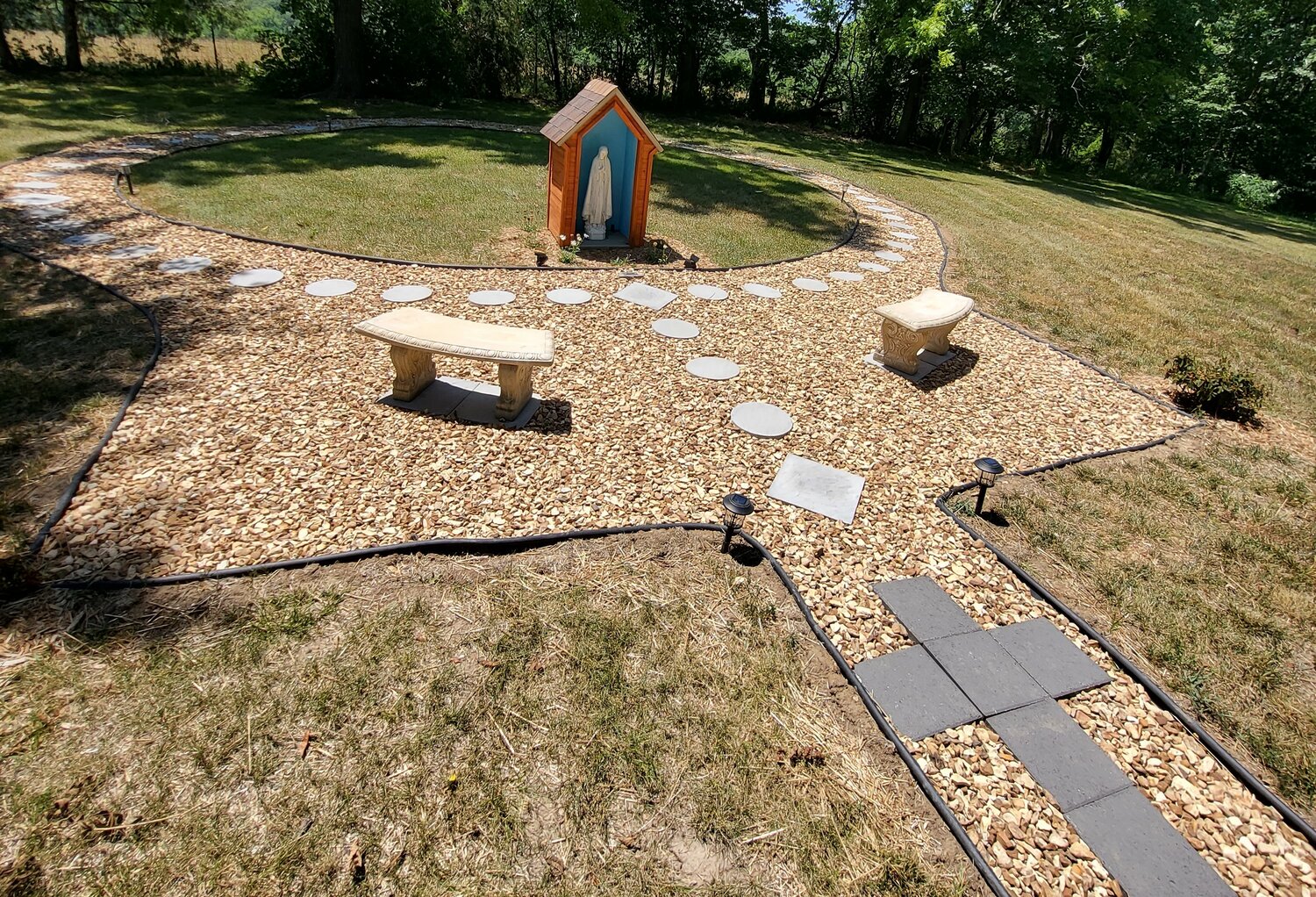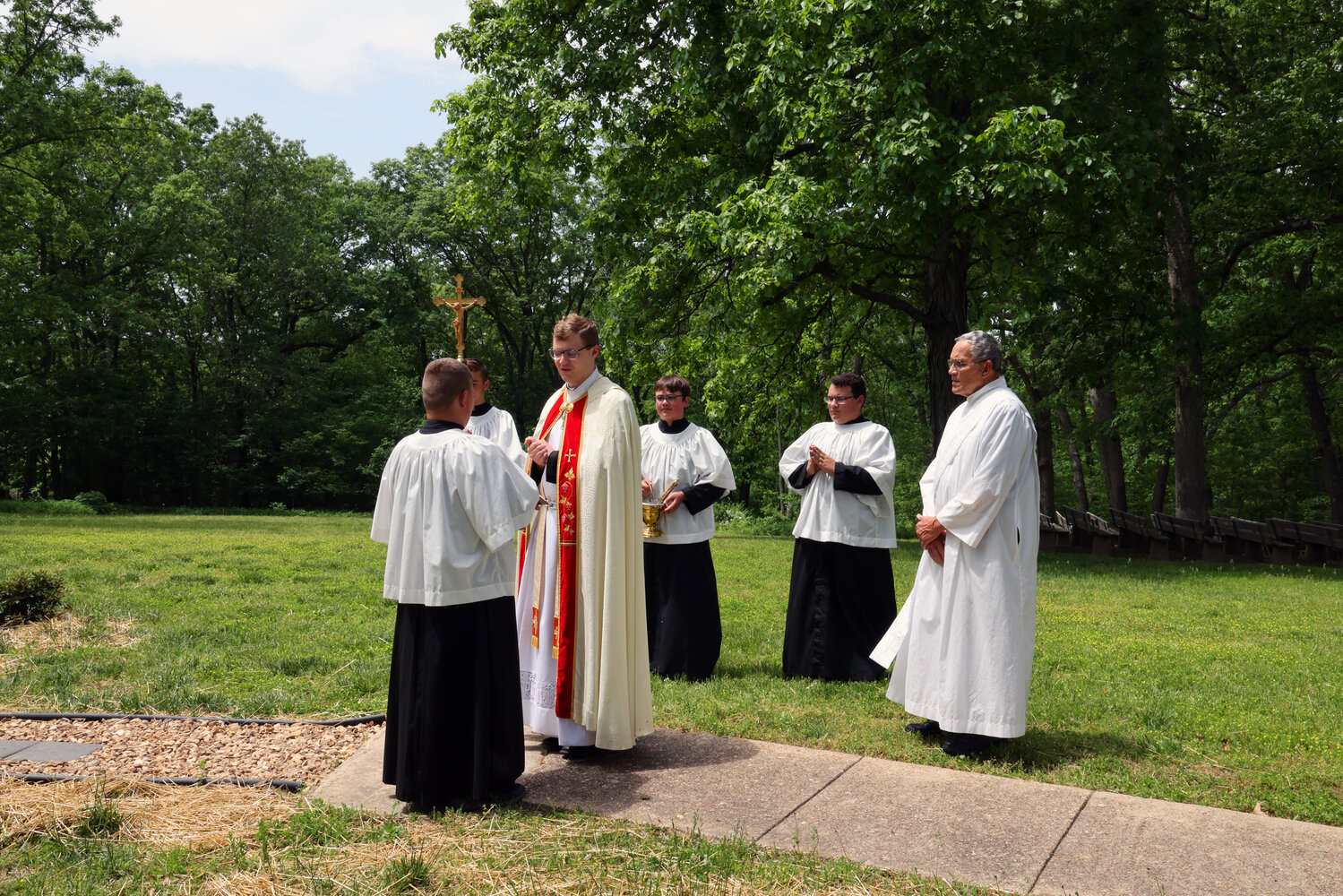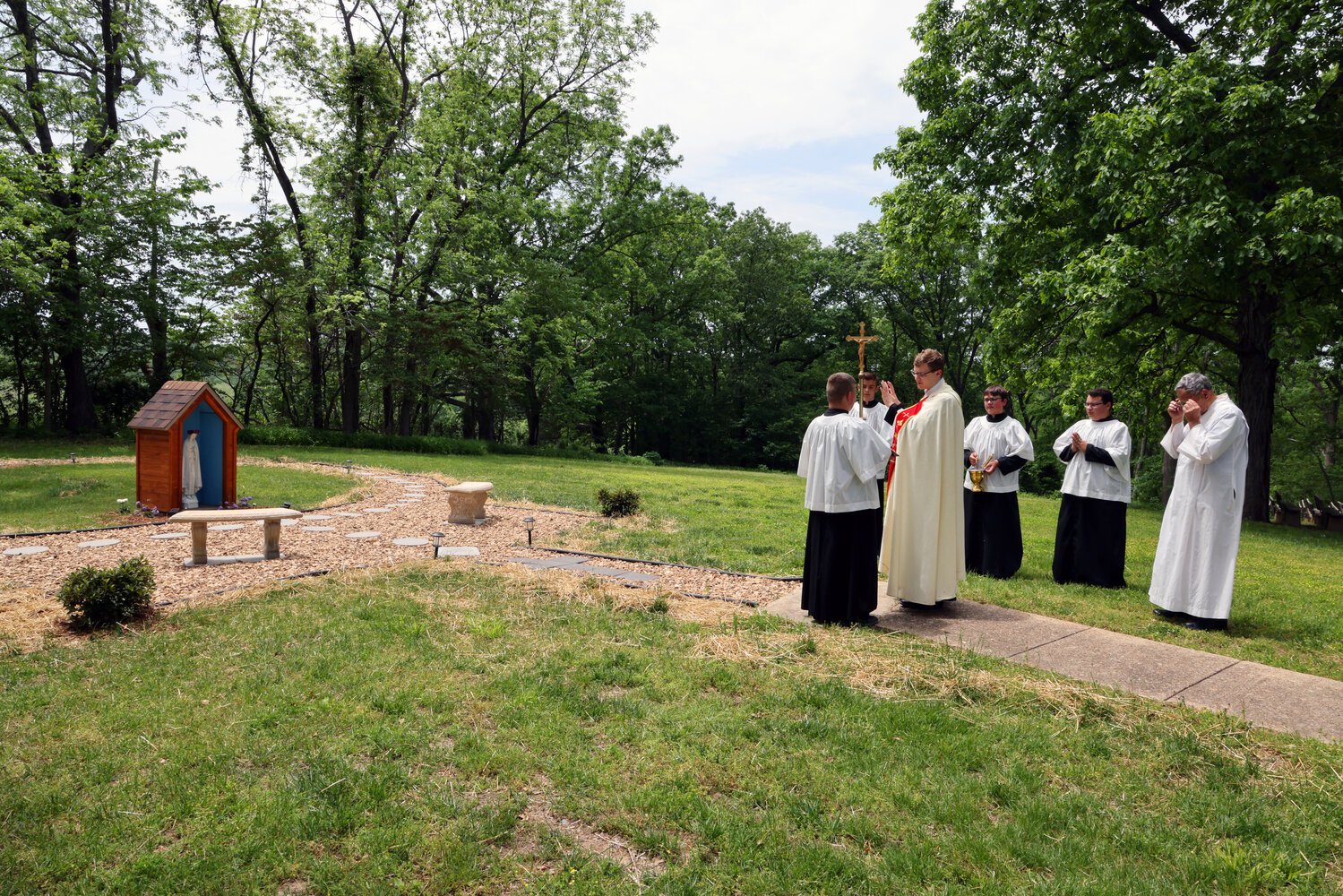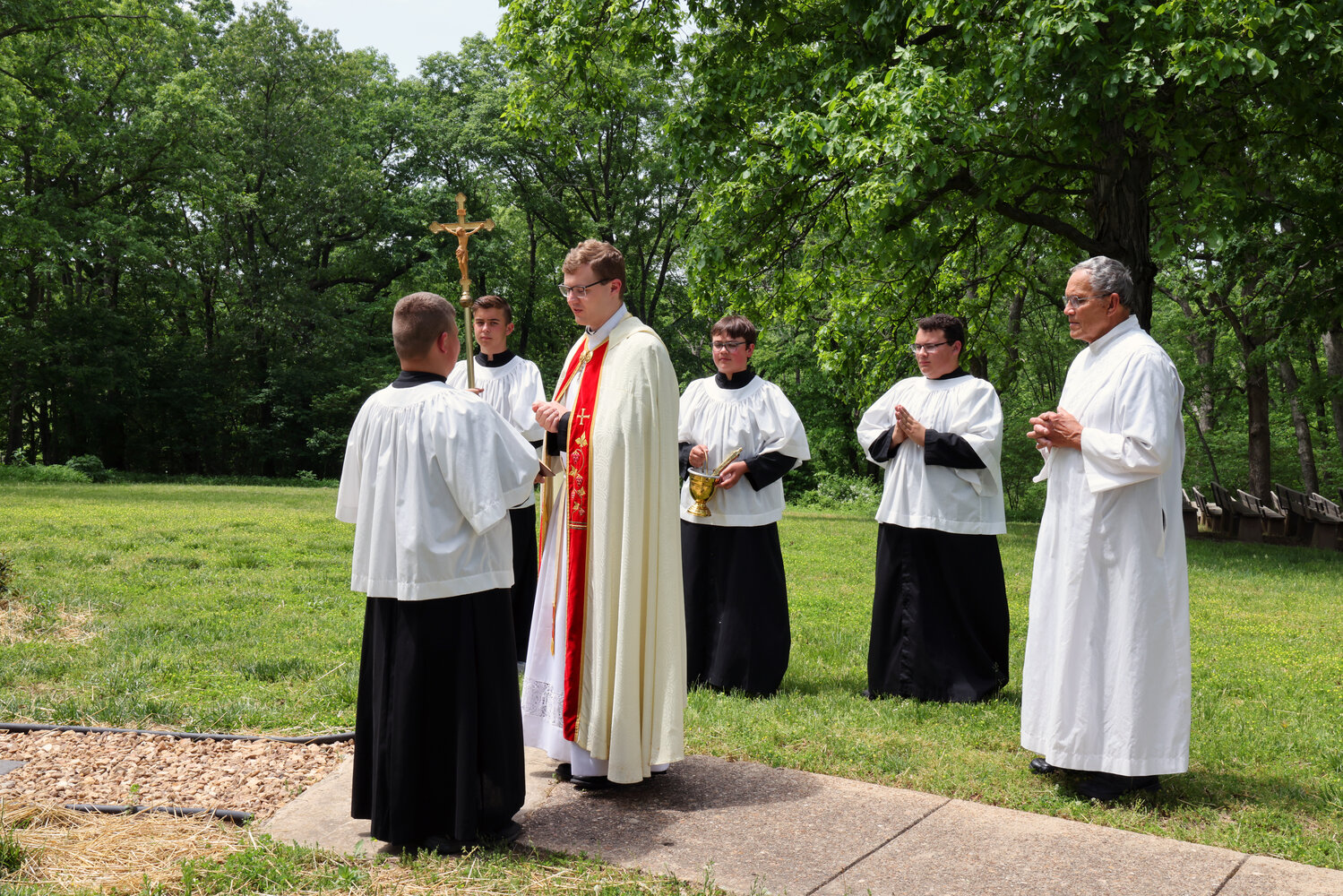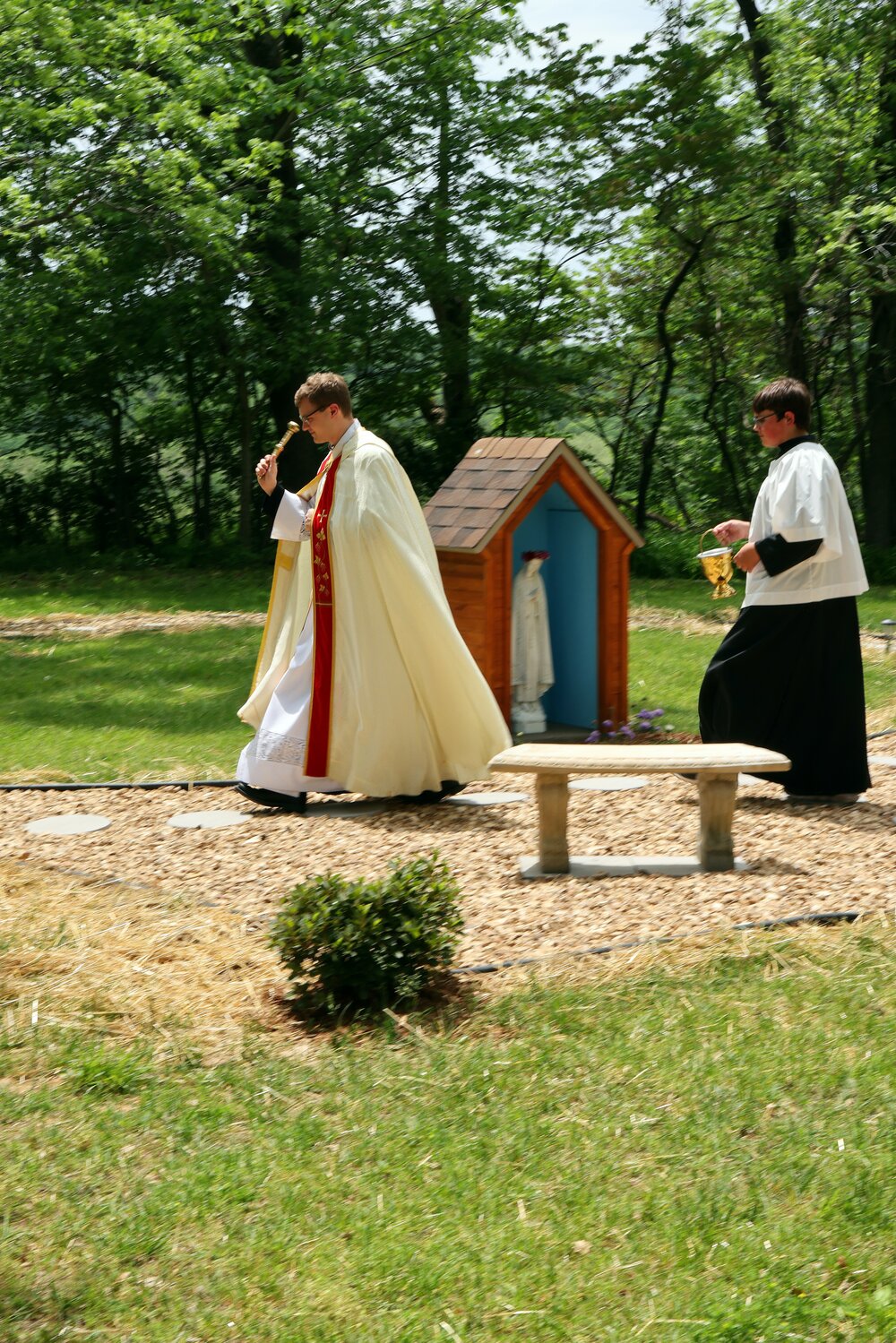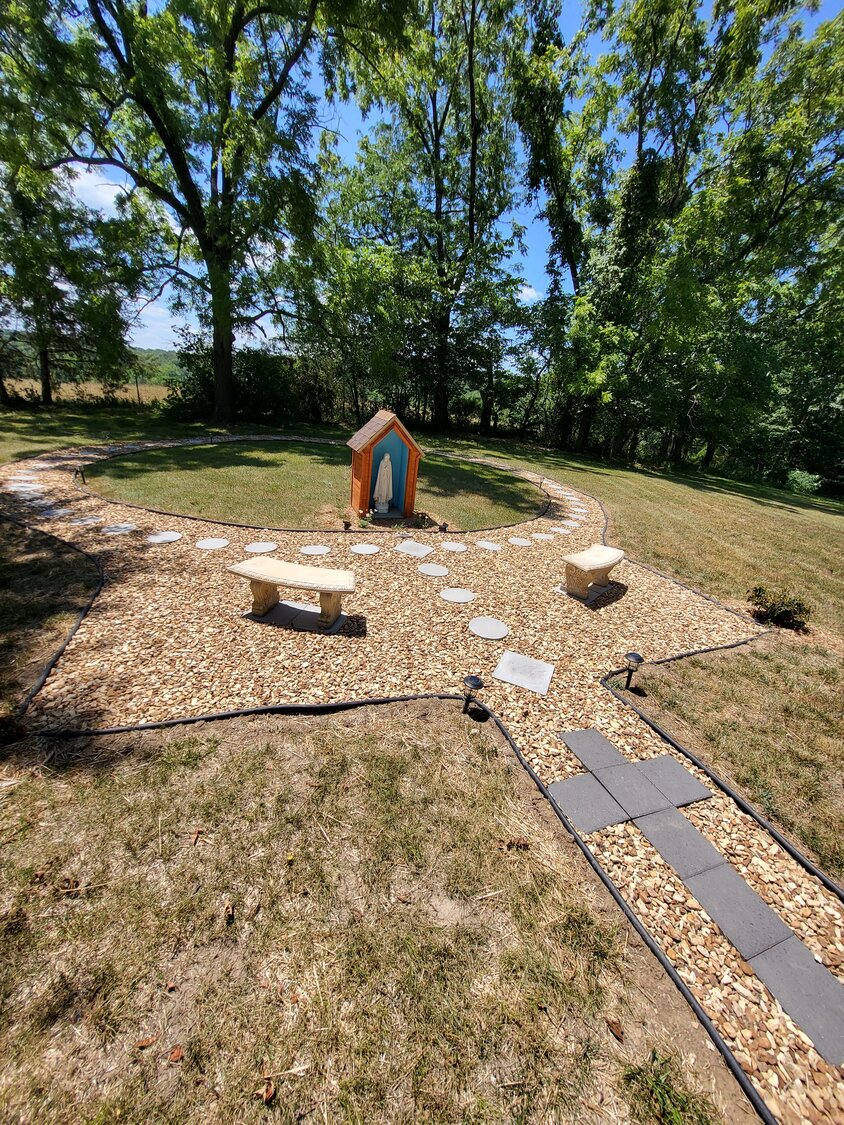Eagle Scout candidate builds Rosary Walk at Shrine of Our Lady of Sorrows in Starkenburg

SCROLL THE ARROWS to see more photos.
“Your conduct along the trail has been excellent.”
Sam Cramer is looking forward to hearing those words from his Scoutmaster during his upcoming Eagle Scout ceremony.
He also hopes his Eagle Scout project will help generations of people hear that same message at the end of their earthly lives.
Sam, a member of Church of the Risen Savior Parish in Rhineland, built a Rosary Walk on the grounds of the Shrine of Our Lady of Sorrows in Starkenburg.
He and fellow Boy Scouts from Troop 439 in Washington, along with Father Tony Ritter of the St. Louis archdiocese, placed stone pavers and landscaping in the form of a Rosary.
Pilgrims can now walk the circular path near the shrine’s stone chapel while praying the prayers and meditating on the mysteries.
“Especially when you’re praying the Sorrowful Mysteries, the sense of walking with Christ up to Calvary and then with his body being carried back down to the tomb: that’s what I was hoping to achieve with this,” Sam stated.
At the center of the Rosary Walk, directly in line with the cross-shaped paver, is a statue of the Blessed Mother as she appeared to the children at Fatima, Portugal, in 1917.
“She — Our Lady of Fatima — is who it’s dedicated to,” Sam noted.
Eagle’s wings
Eagle Scout is the highest rank in Boy Scouting.
Sam’s Scouting trail began in fourth grade, when he joined a Cub Scout pack in Hermann.
He continued into Boy Scouts and worked his way up through each rank — beginning with Troop 116 in Hermann and then transferring several years ago to Troop 439 in Washington.
“As you progress through the ranks and challenges, you learn how to survive in the wilderness, how to camp, how to make a fire, how to cook food, how to lead a project, how to calm people down in a dangerous situation, how to lead,” he stated.
The largest requirement for the Eagle rank is a work-service project, which itself challenges and helps develop the scout’s organizing and supervising skills.
Family bonds
Sam has lived near Starkenburg his whole life. Many of his ancestors were members of the former St. Joseph Parish in Rhineland and the former St. Martin Parish in Starkenburg, which in 1979 were combined to form Church of the Risen Savior Parish.
The parish maintains the shrine, which memorializes the sorrow the Blessed Mother experienced at her Son’s passion and death, and the sorrow she still holds for people who ignore or belittle his sacrifice.
About two years ago, Sam started thinking about what he should do for an Eagle Scout project.
“I knew all along that I wanted to do something for the shrine,” he said.
He had been cycling through ideas when his mother saw a Facebook post about a Rosary walk and passed the idea along to him.
Inspired, Sam got to work on preliminary planning — “how much space it would take, what we’d need, how long it would take.”
He attended the next meeting of the committee that promotes and maintains the shrine, and shared the idea with the members.
“There happened to be a woman at the meeting who proposed to the shrine committee to build a Rosary walk,” Sam recalled.
“So on that same night, two people were proposing two versions of the same project,” he said. “What were the odds of that?”
With the committee’s blessing, Sam took the idea back to his Scout troop, which also gave its approval.
He then turned to the national Eagle Scout Board, which reviews and approves proposals for Eagle Scout projects.
Upon receiving the board’s endorsement, Sam set about final planning and fundraising.
“I figured out exact quantities for all the materials and compiled all the feedback,” he said.
Community support
Each candidate for Eagle Scout selects an adult mentor among those who have achieved the rank. Sam chose Fr. Ritter, the former associate pastor of St. Francis Borgia Parish in Washington and the former chaplain of the Scout troop sponsored by the parish.
Sam set up a table outside Valentine Hall on the shrine grounds during last year’s Fall Pilgrimage.
He continued greeting people outside the Second Tuesday Masses in the shrine chapel and Sunday Masses at the Church of the Risen Savior in Rhineland.
“Along the way, a lot of people told me it would take ages for me to raise the money and to maybe think about cutting expenses,” Sam recalled.
He remained committed to raising about $3,500 — enough to pay for what he intended to build.
“It wound up taking about a month-and-a-half to get the money,” he said.
Aside from a pledge from his dad’s employer, all the money came from people in the Starkenburg/Rhineland/Hermann area.
“That’s one of many things that had me thinking that this is something God wants me to do,” he said.
He also took it as assurance that the community was fully invested in the project and wanted to help.
Benefactors included individual parishioners as well as the Knights of Columbus Council 1914 and the St. George Parish Ladies Sodality, both in Hermann.
Answered prayers
Sam set about buying materials and setting up work dates with fellow Scouts from Troop 439.
Construction began on Feb. 17, the Friday before Ash Wednesday.
“From there, every Saturday when we could, we started having work days and going down to work on it,” said Sam.
He, his brother Max Cramer and a handful of fellow Scouts joined in the labor.
Several adults volunteered to drive the Scouts to Starkenburg and serve as chaperones.
Sam enjoyed working beside Fr. Ritter and fellow Scouts.
“For the older ones, it was a bonding experience,” said Sam. “And for the younger ones, it was a learning experience.”
Work progressed until mid-March, when torrential rains brought a decisive halt.
“We had to keep canceling our work days,” Sam recalled. “It was impossible to work without destroying our equipment and everything around us.”
He remained prayerfully steadfast that the work would be completed in time for the Rosary Walk to be dedicated on May 13, the Feast of Our Lady of Fatima.
There were suggestions to move back the date, but Sam wouldn’t budge.
“And somehow, the horrible weather cleared out,” he recounted. “We mustered a lot of power and did a lot of work on it.
“And somehow, by some miracle, even though it seemed impossible, we made it to the deadline.”
Well-worn path
Sam put the finishing touches on the project the morning of the feastday.
That afternoon, Fr. Ritter celebrated a dedication Mass and blessed the Rosary Walk.
The people then used it to pray the Rosary together.
“The Rosary Walk has seen wide use since being installed this spring. Many groups and individuals have used this visual rosary to aid in their Marian devotion,” Father Philip Niekamp, pastor of St. George Parish in Hermann and Church of the Risen Savior Parish in Rhineland and spiritual director of the Shine of Our Lady of Sorrows, recently stated.
He noted that benches have now been placed next to the Rosary Walk for people who want to stop by to pay and contemplate the Mysteries of the Rosary.
Looking back at the generations of people who have worn paths to the chapel and grottos at the shrine, Sam realized that the grandchildren of people who aren’t born yet could wind up praying along this Rosary Walk someday.
“When I started the project, I knew I wanted something that not only would last a long time, but would also leave a good impression and have a lasting benefit,” he said.
He believes the people who benefit the most from the Rosary Walk will be those who seek the Blessed Mother’s help in figuring out what God wants them to do, and then doing it.
He also asked for prayers of thanksgiving.
“Keep in mind all the work throughout the shrine,” Sam requested. “Remember the ancestors and all the backbreaking labor it took to build everything, and thank God for them.”
Comments
Other items that may interest you
Services
The Catholic
Missourian
2207 W. Main St.
Jefferson City MO 65109-0914
(573) 635-9127
editor@diojeffcity.org

